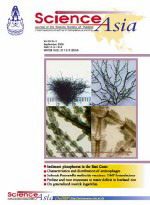ThaiScience
ThaiScience
SCIENCE ASIA
Volume 47, No. 02, Month APRIL, Year 2021, Pages 131 - 142
Salinity translating information from model microbes into crop plants
Naveen K. Sharma, Meenakshi Singh, Ashwani K. Rai
Abstract Download PDF
Because of the gradual increase in soil salinity worldwide, the study of halophiles nowadays is an important emergent discipline. High salinity limits the microbe’s diversity, community structure and their metabolic activities, consequently reducing the soil fertility. This leads to decreased crop yield that presents a grave and global socioeconomic problem. Crop plants are relatively more sensitive, and their growth inhibition and reduction in the yield usually occur at salinity of 50 mM or above. Halophilic and halotolerant organisms that live and acclimate/adopt to high salinity environments have various strategies to survive, protect their proteins and other cellular processes to grow in the challenging environment. They possess efficient mechanisms to sense the stress signals by, for instance, signal transducing systems, alteration of the composition of the membranes, exclusion of Na+ and prevention of K+ leakage from the cells, and synthesis of organic solutes. In this article, we also discuss the responses of these organisms such as alteration in photosynthesis and respiration, nitrogen nutrition, reactive oxygen generation and programmed cell death, and adjustment and/or adaptation to salt stress, along with the exploration of efforts like salt priming and memory, and genetic engineering for developing salt tolerant crop plants.
Keywords
cyanobacteria, halophile, reactive oxygen species, salt primingSCIENCE ASIA
Published by : The Science Society of Thailand
Contributions welcome at : http://www.scienceasia.org/
